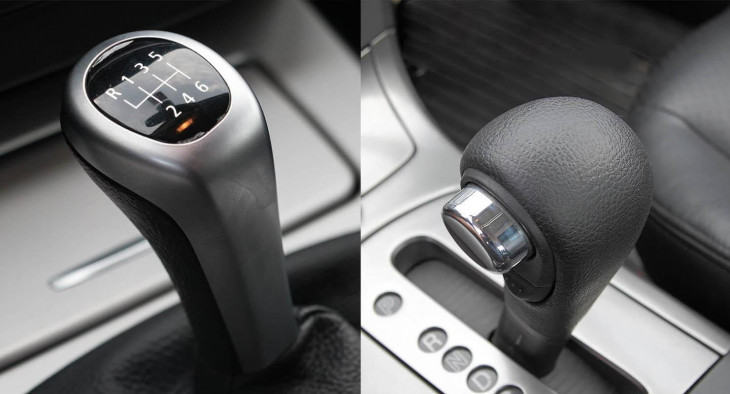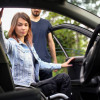By The Acclaim Team on 18th June 2021 in News
The majority of cars in the UK are manual, which is why most new drivers naturally choose to learn in a manual car. With that being said, demand for automatic cars is on the rise.
When it comes to your choice of vehicle, it’s important that you make the right decision to avoid having to go back to retake your test. After all, with a manual licence, you are fully able to drive both manual and automatic, whereas an automatic licence restricts you to only driving automatic vehicles.
Both manual and automatic cars have their strengths and weaknesses, and what works best for others may not work best for you. This guide explains everything you need to know about manual and automatic cars to help you make the best decision for you.
What Is the Difference Between Automatic and Manual?
The difference between manual and automatic cars is transmission. With a manual car, you are required to change gears while driving, whereas with an automatic car (you guessed it), the gears change automatically.
When changing the gears in a manual car, you’ll need to hold down the clutch pedal to manually change gear. You’ll have three pedals - the clutch, one for braking and one for accelerating. As the gears change automatically in an automatic car, you only have two pedals - one for accelerating and one for braking.
Automatic cars do not have a clutch and are only controlled with an automatic gear stick with four modes - park (P), reverse (R), neutral (N) and drive (D).
Manual VS Automatic: Advantages and Disadvantages
Manual Cars
As manual cars are far more common than automatic cars and are easier to find, manual cars are generally more affordable and easier to maintain. The gearbox technology is less complex than an automatic car, making repairs affordable, too.
Manual cars are typically faster than automatic cars as they are better at transferring power from the engine to the wheels. Manual cars have also got a reputation for their ease of control compared to automatic cars, particularly in difficult driving conditions.
The only real disadvantage to driving a manual car is that they can initially be a little trickier to get to grips with compared to automatic cars. With that being said, once you get the hang of the gears and clutch, driving a manual is extremely easy.
Automatic Cars
Automatic cars are slightly easier to drive and are more convenient. As you only need to change gears when reversing or parking, it does offer a smoother ride with minimal hassle to allow you to concentrate on driving. If you do need to learn quickly, then an automatic might be the best choice for you.
However, automatic cars generally cost more than manual cars, as there aren’t as many on the road and with a reduced number of options available. As repairs are more expensive on automatic cars, this does mean that it might not be the best option for you as a new driver.
Another major disadvantage is that, if you have an automatic licence, you will not be able to drive a car with manual transmission. And, if you have a manual licence, you’ll be able to drive both manual and automatic.
Automatic VS Manual Car Insurance
As automatic cars are more costly to repair, this does mean that car insurance is slightly more expensive compared to a manual car.
According to MoneySuperMarket, between July and September 2020, the annual cost of insurance cover for automatic licence holders was over £300 a year more expensive compared to those with a manual licence.
Of course, as a new driver, this is something you should take into consideration as your first year of your car insurance is likely to be the most expensive.
Are Manual Cars More Fuel Efficient?
A continuous debate we have seen over the years is that manual cars are more economic and fuel-efficient than automatic cars.
This is generally true as manual cars used to be more fuel-efficient than their automatic counterparts. However, more modern automatic vehicles have improved technology to improve their fuel efficiency, so you may find that newer automatic models can be slightly better on fuel economy, although this isn’t always the case.
Driving Lessons with Acclaim Driving
The gearbox you use has no impact on how good or bad a driver you are. Our best advice is to learn whatever makes you feel more comfortable, whether that be manual or automatic. Manual gearboxes are often associated with high performance or luxury vehicles, however, this is no longer the case. It’s worth bearing in mind that if you do have an automatic licence, you won’t be able to drive a manual car. If you’d like to drive a manual car, you would need to go back and retake your test in a manual car.
Everyone’s different when it comes to driving, so make sure that you think carefully about which type of lessons you’d like to take. There’s less to get your head around with automatic lessons, but this type of licence will only allow you to drive an automatic car. On the other hand, a manual licence qualifies you to drive both types of vehicle and the lessons tend to be cheaper too.
If you’re going to be stuck in a lot of traffic you might prefer an automatic, as you won’t have to be constantly changing gears. Like automatic lessons though, automatic cars are more expensive than manual ones, so you’ll have to bear that in mind. The decision is ultimately yours!
To sum it all up:
Manual
- Cheaper lessons and cars
- Qualifies you to drive both manuals and automatics
- Gives you that little bit more control
Automatic
- Easier and faster to learn
- No risk of stalling
- More pleasant in heavy traffic
Here at Acclaim Driving, we can offer both manual or automatic cars, get in touch now to start driving.




